Food for the Soul: Barbara Hepworth – Women Artists Series 9

Barbara Hepworth. Sphere with Inner Form, 1963. Bronze. Barbara Hepworth Museum, St. Ives, UK. Photo: image (c)2003 Graham Rogers at Wikipedia Commons
By Nina Heyn – Your Culture Scout
Imagine that you are a mother of a four-year-old boy as well as newborn, underweight triplets. You are living in a damp, badly heated basement in 1930s London. The father of the triplets is a renowned painter who has absconded to Paris to live with his legal wife and their children. On top of these challenges, you are yourself an artist who cannot live without sculpting and creating, but carving in stone among boiling cloth diapers and screaming infants is not really an option.
This is not some theoretical situation—this was the impasse of a young sculptor named Barbara Hepworth in 1934 in Hampstead, London. Juggling work and motherhood has always been a dilemma for women, but Hepworth’s case was just a bit more extreme than for many others. She was an artist whose principal medium was stone, who wanted to create despite the constraints of convention and expectations regarding motherhood. While she made extraordinary artistic achievements, she has been criticized in some biographies for her unconventional life choices, such as a divorce (a socially questionable move in the 1930s) and the fact that she did not devote the entirety of her time to caring for her children.
Hepworth, born in 1903 to the family of a civil engineer in Yorkshire, knew already as a child that she wanted to be a sculptor. This was hardly an appropriate goal for a demure woman in Edwardian England. She prevailed, however, attending art schools where she studied alongside another outstanding British sculptor, Henry Moore, traveling to Italy and marrying fellow artist John Skeaping in Florence. Italy influenced Hepworth enormously. In her 1952 autobiography, Carvings and Drawings, she talked about her discovery of southern light—so different from her Northern England experiences—and the joy of carving in marble: “A chance remark by Ardini, an Italian master carver whom I met there [in Rome], that ‘marble changes colour under different people’s hands’ made me decide immediately that it was not dominance which one had to attain over material, but an understanding, almost a kind of persuasion, and above all greater co-ordination between head and hand.”
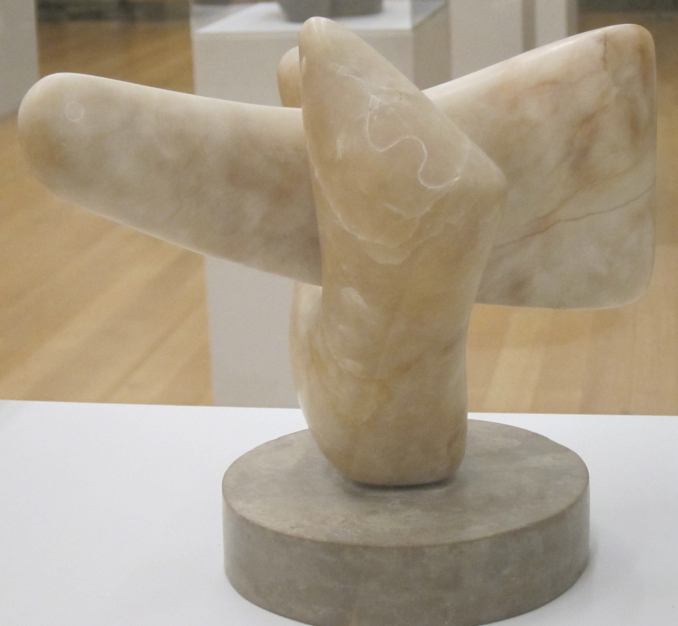
Barbara Hepworth. Two Forms, 1933. Alabaster on limestone base. Tate Britain. Photo: Wikimedia Commons
The end of the 1920s and the beginning of the 1930s was a period of rapid changes in Hepworth’s personal life and a period of major artistic growth. On their return from Italy, Hepworth and Skeaping settled in London, where Hepworth bore their son Paul and started carving in earnest. However, a few years after Paul’s birth, she started attending plein air gatherings in Norfolk with fellow artists, and there she met abstract painter Ben Nicholson. In 1931, they started a relationship, and she divorced Skeaping the same year. Three years later, her triplets were born. She most likely suffered from postpartum depression, since she later described in detail her bouts of uncontrollable crying during this period. The burdens of caring for four-year-old Paul and the newborns were so great that for a few months, she had to have the babies cared for in a nursery home. It took a good few years before the incompatibility of ordinary life mixed with art eased somewhat in her life.

Barbara Hepworth. Pierced Form, 1932. Photo by Paul Laib/Courtauld Institute, London. Sculpture destroyed during WWII. Photo: Wikimedia Commons
Artistically, this was Hepworth’s period of invention and perfecting the medium (stone carving at the time was less popular than sculpting). She started carving stones with pierced holes, creating compositions that included an abstract shape and empty space, both of which would complement and define the other. She was carving what Picasso rendered in paint and Calder in wire—the relationship between an empty and a filled space. Nicholson—a leading abstract modernist in Britain—also influenced her lifelong devotion to abstract art.
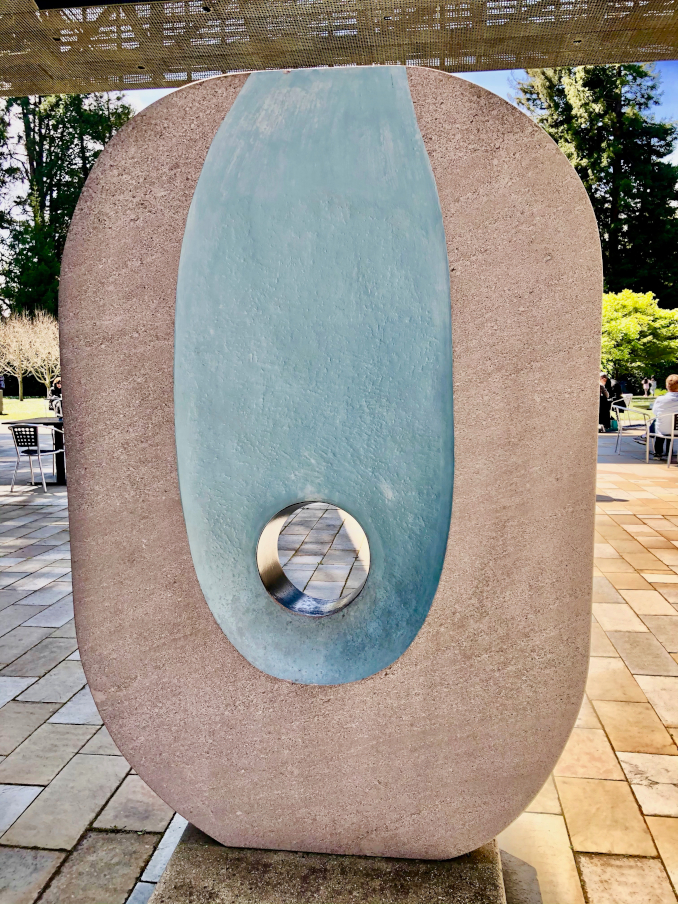
Barbara Hepworth. Pierced Monolith with Colour, 1965. De Young Museum, San Francisco. Photo: Nina Heyn
Despite recognition in the form of some gallery shows, Hepworth and Nicholson lived in relative poverty. City life was not conducive to creativity, so they started spending more time away from London. Hepworth wrote: “I have gained very great inspiration from the Cornish land — and seascape, the horizontal line of the sea and the quality of light and colour which reminds me of the Mediterranean light and colour which so excites one’s sense of form; and first and last there is the human figure which in the country becomes a free and moving part of a greater whole. This relationship between figure and landscape is vitally important to me. I cannot feel it in a city.”
In 1939, a few days before England entered WWII, Hepworth and Nicholson moved to the artists’ colony of St. Ives in Cornwall. They stayed there for ten years, inspiring and helping other artists and launching a very fertile period in both artists’ biographies. While Nicholson eventually left both Cornwall and Hepworth, she stayed there for life, purchasing land around her studio to create an ever-expanding, open-air display of her large sculptures.

Barbara Hepworth’s studio at St. Yves. Photo: Wikimedia Commons
Many of Hepworth’s sculptures, especially in her postwar years, were created as public commissions. One of the most famous was her Single Form (1964) installed in front of the United Nations headquarters in New York.
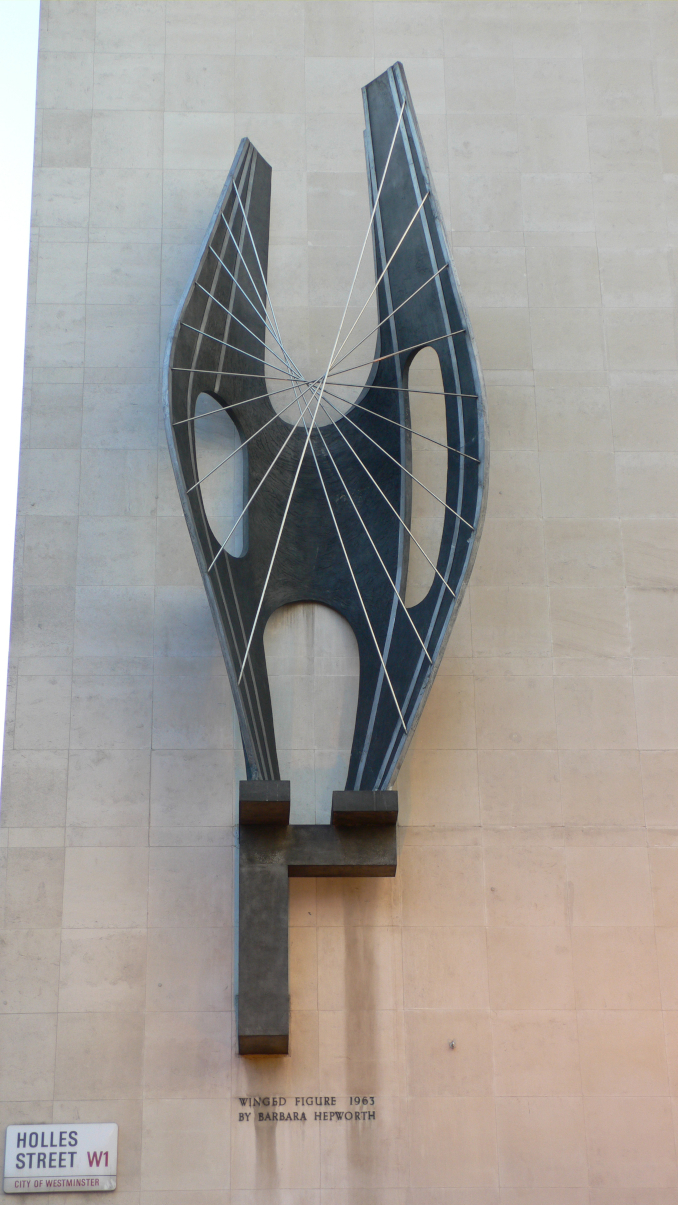
Barbara Hepworth. Winged Figure, 1963. Aluminum and steel rods. John Lewis building, London. Photo: Wikimedia Commons
In 1961, John Lewis, the owner of the Oxford Street department store, reached out to several British sculptors requesting proposals for a large sculpture to enliven the beige Portland stone façade of his flagship building in central London. Hepworth’s design won (after rejection of an earlier project); it was manufactured in steel and installed in 1963. The commission was supposed to express “the idea of common ownership and common interests in a partnership of thousands of workers.” This abstract construction is certainly impressive and a popular London landmark, even if it is debatable whether the crisscrossing steel cables actually signify a “partnership of workers.”

Barbara Hepworth. Corinthos, 1954-1955. Guarea wood, paint, wooden base. Tate Liverpool. Photo: Wikimedia Commons
Hepworth’s sculptures were rarely figurative, but she did create one in 1954, a figure entitled Madonna and Child, a sort of modernist Madonna that is now placed at St. Ives parish church. This unusual carving was prompted by the tragic death of Hepworth’s son Paul in a flight accident in 1953. The following year, she traveled through Greece to get over her grief, and on her return, she started carving some of her loveliest pieces inspired by Greek landscape and architecture. Corinthos is carved from Nigerian guarea wood and painted white inside to contrast better with the brown hue of the outside. It reminds me of a freshly fallen chestnut when the brown nut skin is still shiny and incredibly smooth. Unlike the large stone and bronze public sculptures, this piece is intimate—it seduces the viewer into wanting to touch it and run a hand over it.
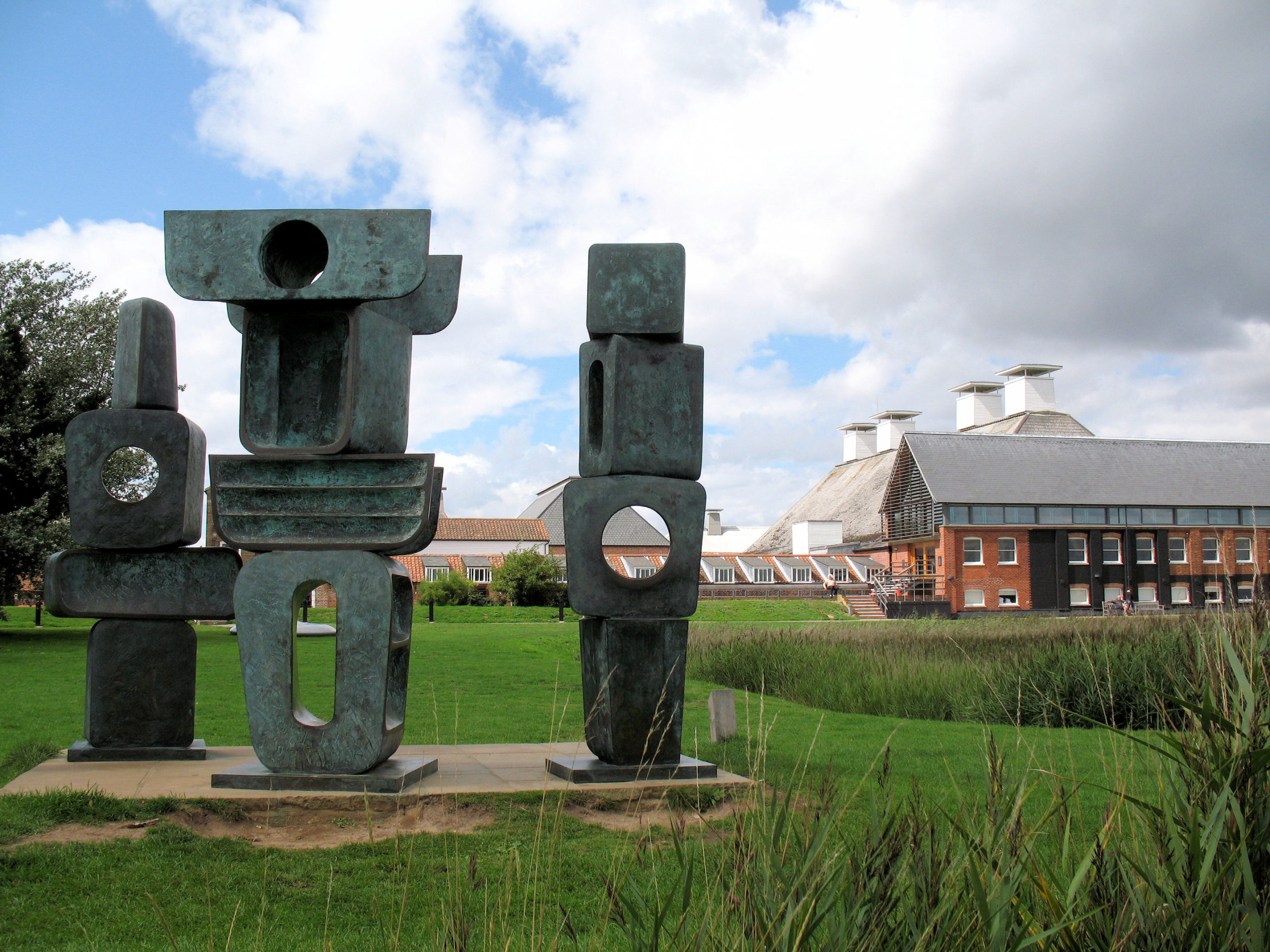
Barbara Hepworth. Three of the nine figures from The Family of Man, 1970. Snape Maltings, UK. Photo: Wikimedia Commons
Considered her masterpiece, Hepworth created The Family of Man as a group of nine, 10-foot bronzes (with the individual figures given titles such as Ancestor II, Girl, Parent 1, Youth, and so on). One complete set is displayed at Yorkshire Culture Park in the UK, while the other set’s sculptures are dispersed. It was the last major work by Hepworth before her demise in 1975 (she died tragically in a studio fire started by her cigarette).
After her passing, Hepworth’s carving studio in St. Yves was transformed into a museum, where many of her memorable sculptures from different decades are displayed in the surrounding garden that was her creative oasis for so many years. This is where her children grew up, where her beloved pet cats wandered, and where she created her unique, sinuous abstractions in stone and bronze.
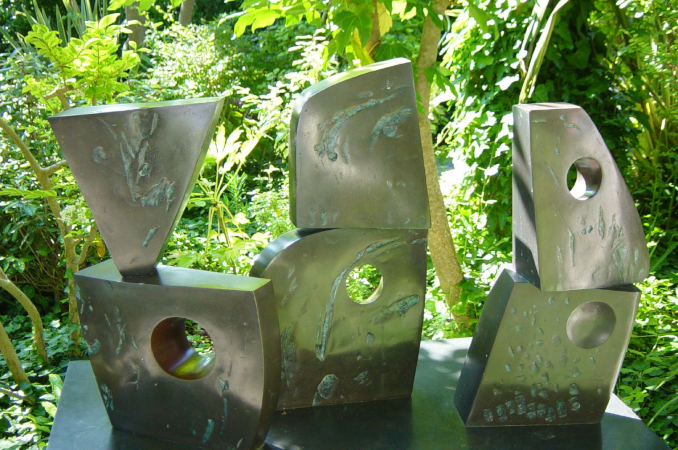
Barbara Hepworth. Six Forms, 1968. Barbara Hepworth Museum, St. Ives. Photo: Wikimedia Commons
Another location where you can see a collection of Hepworth’s art is a museum in her native city of Wakefield in Yorkshire. The Hepworth Wakefield Museum has just mounted a retrospective exhibition to celebrate the tenth anniversary of the gallery. Traveling restrictions will probably mean diminished access to this exhibition, but it will stay open for almost a year (May 21, 2021 – Feb. 27, 2022).
